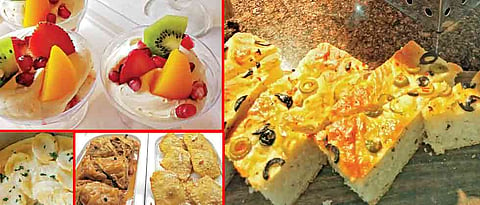

Recently, I attended a Cyprus lunch preview at ITC Maurya, New Delhi, organised in collaboration with the High Commission of Cyprus. This was an exclusive and first of its kind opportunity to discover the Cypriot cuisine in the aegis of the High Commissioner and his team. While I was keen to join this culinary journey, I was nervous about my ignorant self. The country, touted as the birthplace of Aphrodite (Cypriot goddess), was unknown to me. I will not shy away from accepting the fact that I really did not know much about this Mediterranean beauty except that it is a living treasure of Greek and Turkish traditions.
Coming to the lavish spread, prepared by special chefs Aimilios Aslanis and Katerina Fragkopoulou who wanted to introduce me and the other guests to the rich, varied and flavoursome Cypriot cuisine, I would have to say that it was filled with the goodness of fruits, vegetables, fresh breads, salads, olives, sauces, meat and fish. The Turkish, Greek and Middle Eastern influence was evident in many ways.
Telling us a little more about his country’s cuisine, the High Commissioner, Agis Loizou, mentioned that Cypriots take eating very seriously and are high on love for life and love for food. With this he left us free to discover it for ourselves.
FOR NON-VEG AND VEG LOVERS
The tantalising menu, along with the wines, coffee and the Cyprus Island products, offered me a great insight into their culinary tradition. What I learnt is that the mild climate and fertile soil of the island is suitable for staples such as figs, beans, chickpeas, herbs, olives, dates and almonds. Rest assured, vegetarians will never have a dull moment. Louvi are the black-eyed beans and they are loved by Cypriots. Even the buffet spread promised a lot of options for veg lovers with the use of peppers, tomatoes, onions, eggplants and vegetable stuffing.
Some of the dishes that I tasted were salads, Koupepia (dolmades), Tirokafteri, Lahano Keftedes, Halloumi Pies, Tomato Keftedes, Baklava, Daktyla, Grilled Halloumi stuffed peppers, varieties of hummus, pita bread, fish baked in salt, Ravioli with Halloumi and Mint and Lamb Chops.
Further interaction with the chefs helped me learn that Cypriots love to grow vegetables and fruits, especially oranges and grapefruit. They love mezze platters and are fond of lamb, pork and rabbit meat. The cooking methods are simple and traditional with a preference for olive oil, grilling and deep fat frying. Usually, the whole fish is baked while the lamb is slow cooked.
Situated at the crossroads of three major continents — Europe, Asia and Africa, Cyprus has a very intriguing and strategic placement on the world map. While the island’s Greek roots are known to all, the multi-cultural influence of the Phoenicians, Assyrians, Franks, Venetians, Ottomans and British has also played a key role in developing its traditional as well as diverse cuisines.
The never heard of names of dishes got me asking for more and a little effort made me learn that Keftedes means meatballs, Koupepias are most famous traditional Cyprus dishes that are rolled in vine leaves and stuffed with meat and rice, and Tirokafteri is a cheese-spicy Greek dip. Lahano Keftedes are vegetarian croquettes, also called a traditional village dish made from vegetables. While Daktyla are Greek sweet pastries, Baklava are heavenly treats made with thin layers of dough and filled with honey-soaked layers, nuts and spiced walnuts. I had tasted my first Baklava in Riyadh and this one was different. In fact, the first Baklavas came from the Ottomans and it is prepared differently in Middle Eastern countries.
This was my first introduction to the Cypriot history, food and culture and a very compelling one too. For all those who are always eager to visit a new country to explore and indulge, Cyprus seems to be a treat. A small presentation on tourism, which happened at the food festival, was enough to make me curious about Mediterranean bliss, pine-clad Troodos Mountains, stone-built churches, Byzantine icons, world heritage mosaics, crystal waters of Ammochostos, romance and history of Pafos, hidden gems and the Aphrodite cultural route.
(The writer is a traveller, and blogger who blogs at www.manjulikapramod.com)
DON’T MISS OUT ON
